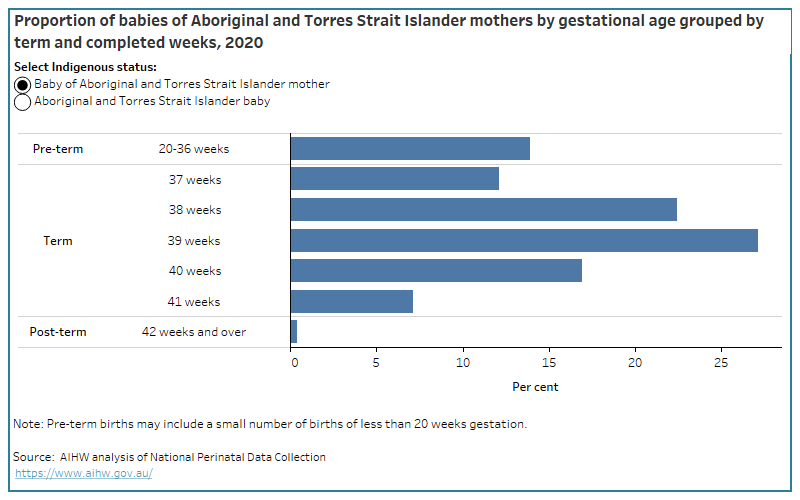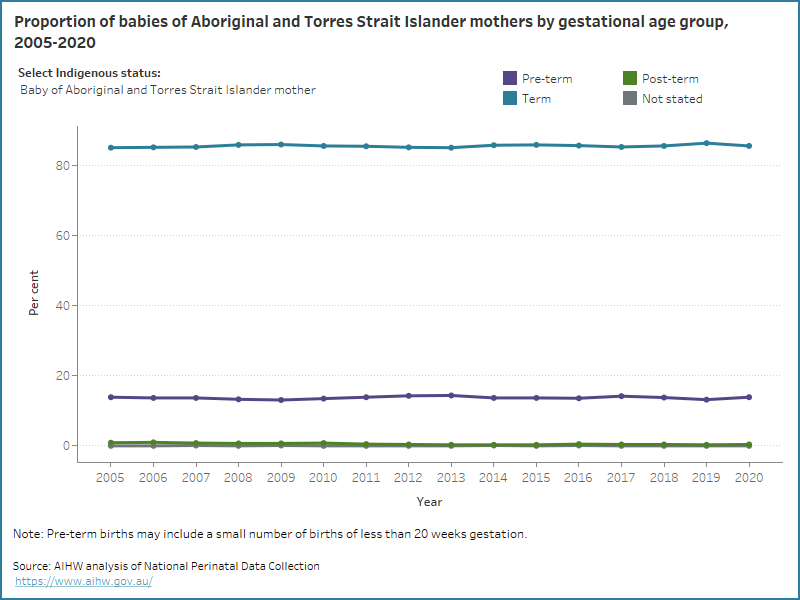 Gestational age
Gestational age
On this page:
Gestational age is the duration of pregnancy in completed weeks. Gestational age is reported in 3 categories: pre-term (less than 37 weeks’ gestation), term (37 to 41 weeks) and post-term (42 weeks and over).
Pre-term birth often occurs spontaneously, however pre-term birth can be related to maternal or obstetric conditions such as maternal diabetes, hypertension or infection and with risk factors such as maternal smoking (WHO 2012). Pre-term birth is linked to perinatal mortality, developmental delay and chronic disease in adulthood (WHO 2012). Whilst some causes of pre-term birth are unavoidable, there remain many modifiable risk factors for pre-term birth which can be addressed (WHO 2012).
Services for Aboriginal and Torres Strait Islander mothers that are developed in partnership with the community are associated with increased antenatal care attendance for pregnant Aboriginal and Torres Strait Islander women, and antenatal care attendance is in turn associated with a decrease in pre-term birth (Kildea et al. 2019).
In 2020, 86% of babies of Aboriginal and Torres Strait Islander mothers were born at term, 14% were born pre-term and 0.4% were born post-term (compared with 92%, 8.1% and 0.4%, respectively, of babies of non-Indigenous mothers).
The data visualisation below presents data on the grouped gestational age of pre-term and post-term babies of Aboriginal and Torres Strait Islander mothers and Aboriginal and Torres Strait Islander babies, and the individual completed weeks for term babies of Aboriginal and Torres Strait Islander mothers and Aboriginal and Torres Strait Islander babies, for 2020.
Figure 1: Proportion of babies of Aboriginal and Torres Strait Islander mothers and Aboriginal and Torres Strait Islander babies by gestational age (grouped by term and completed weeks) for 2020
Bar chart showing gestational age of babies of Aboriginal and Torres Strait Islander mothers. 39 weeks was the most common gestational age.

Over time, the proportion of babies of Aboriginal and Torres Strait Islander mothers by gestational age group has remained largely unchanged. Between 2005 and 2020, the proportion of those born pre-term ranged from 14% to 13%, those born at term ranged from 87% to 85% and those born post-term ranged from 0.3% to 1.0%.
The data visualisation below shows the proportion of babies of Aboriginal and Torres Strait Islander mothers and non-Indigenous mothers by gestational age group from 2005, and the proportion of Aboriginal and Torres Strait Islander babies and non-Indigenous babies by gestational age group from 2013.
Figure 2: Proportion of babies of Aboriginal and Torres Strait Islander mothers, babies of non-Indigenous mothers, Aboriginal and Torres Strait Islander babies and non-Indigenous babies, by gestational age group from 2005 to 2020
Line graph of gestational age group by Indigenous status. Most babies of Aboriginal and Torres Strait Islander mothers were born at term.

Pre-term and term
In 2020, babies of Aboriginal and Torres Strait Islander mothers who were born at term were more likely to have a healthy or high birthweight (96% and 94%, respectively, compared with 33% of low birthweight babies).
Additionally, greater proportions of babies of Aboriginal and Torres Strait Islander mothers were born at term, if they were:
- born to mothers who lived in the least disadvantaged areas (90%, compared with 85% for the most disadvantaged areas)
- born to mothers who lived in Major cities or Inner regional areas (both 87%, compared with 83% for Remote areas and Very remote areas)
- born to mothers aged 20-24 years or 25-29 years (both 87%, compared with 79% for babies of mothers aged 40 years and over)
- born to mothers with a parity of 1 (89%, compared with 81% of those born to mothers with a parity of 4 or more)
- born to mothers who did not smoke (89%, compared with 83% of those born to mothers who smoked)
The data visualisation below presents data on pre-term and term babies of Aboriginal and Torres Strait Islander mothers and Aboriginal and Torres Strait Islander babies, by selected maternal and baby characteristics for 2020.
Figure 3: Proportion of pre-term and term babies of Aboriginal and Torres Strait Islander mothers and Aboriginal and Torres Strait Islander babies by selected topic for 2020
Bar chart for pre-term and term gestational age by selected topics. 86% of babies of Aboriginal and Torres Strait Islander were born at term.
Being born at term was more common in some geographical locations. Explore the map below to view data on the number and proportion of babies of Aboriginal and Torres Strait Islander mothers and Aboriginal and Torres Strait Islander babies who were born at term, by IREG and PHN for 2020 and SA3 for 2017-2020.
Figure 4: Proportion of babies of Aboriginal and Torres Strait Islander mothers and Aboriginal and Torres Strait Islander babies born at term by various geographies
Map of proportions of babies of Aboriginal and Torres Strait Islander mothers and Aboriginal and Torres Strait Islander babies who were born at term across Australia grouped by various geographies.
For related information see the Regional Insights for Indigenous Communities section on Pre-term birth.
Post-term
As only 53 babies of Aboriginal and Torres Strait Islander mothers were born post-term in 2020, analysis of post-term birth by other characteristics combines 4 years of data. Between 2017 and 2020 there were 204 post-term babies of Aboriginal and Torres Strait Islander mothers. These babies were more likely to be born to mothers who:
- lived in the most disadvantaged areas (42% (85))
- were aged 25-29 years (32% (66))
- were first-time mothers (51% (104))
- were a healthy weight (33% (67) or overweight (33% (67)).
References
Kildea S, Gao Y, Hickey S, Kruske S, Nelson C, Blackman R, Tracy S, Husrt C, Williamson D and Roe Y (2019).’Reducing preterm birth amongst Aboriginal and Torres Strait Islander babies: A prospective cohort study, Brisbane, Australia’, EclinicalMedicine 12, doi: 10.1016/j.eclinm.2019.06.001.
WHO (World Health Organization) (2012) Born too soon: the global action report on preterm birth Geneva: World health organisation, accessed 17 October 2022.


